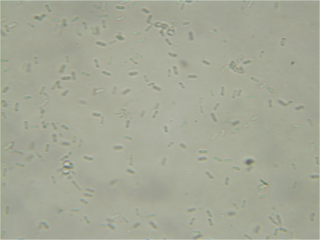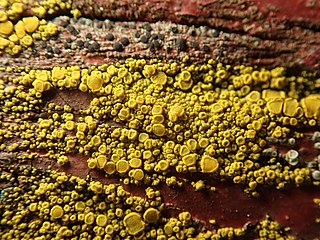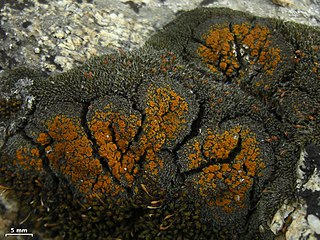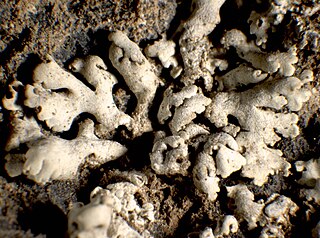
Phoma is a genus of common coelomycetous soil fungi. It contains many plant pathogenic species.
Zwackhiomyces is a genus of lichenicolous fungi in the family Xanthopyreniaceae. The genus was circumscribed by Martin Grube and Josef Hafellner in 1990, with Zwackhiomyces coepulonus assigned as the type species.

Candelariella is a genus of bright yellow, ocher, or greenish yellow crustose or squamulose lichens in the family Candelariaceae. Members of the genus are commonly called eggyolk lichens, goldspeck lichens, or yolk lichens. The genus was circumscribed in 1894 by Swiss lichenologist Johannes Müller Argoviensis, with Candelariella vitellina assigned as the type species.

Candelariella aurella, the hidden goldspeck lichen or eggyolk lichen, is a yellow crustose lichen in the family Candelariaceae. It is commonly found on calcareous rock or wood or bark exposed to sunlight and which may have calcareous dust in areas with lime soils. The thallus is areolate with scattered small (0.1–0.3 mm), rounded to elongated yellow areolas. It has a global distribution and occurs on limestone and calcareous sandstone in the Sonoran Desert in Arizona, California, and Baja California. It occurs in Joshua Tree National Monument.

Muellerella lichenicola is a species of lichenicolous fungus in the family Verrucariaceae. It was first formally described as a new species in 1826 by Søren Christian Sommerfelt, as Sphaeria lichenicola. David Leslie Hawksworth transferred it to the genus Muellerella in 1979.

Muellerella ventosicola is a species of lichenicolous fungus in the family Verrucariaceae. It shows preference to growing on species of the genus Rhizocarpon but can also associate with other genera.

Parvoplaca is a genus of lichen-forming fungi in the family Teloschistaceae. The genus was circumscribed in 2013 by Ulrik Søchting, Patrik Frödén, and Ulf Arup.

Muellerella pygmaea is a species of lichenicolous fungus in the family Verrucariaceae. It has a cosmopolitan distribution in Arctic-alpine areas and grows on the thallus and apothecia of a number of hosts.
Polycoccum anatolicum is a species of lichenicolous fungus in the family Polycoccaceae. It was described as a new species by Mehmet Gökhan Halici and Hatice Esra Akgül in 2013. The type specimen was collected growing on the thallus of the dust lichen Lepraria incana, which itself was growing on the trunk on a Prunus species in western Turkey at an altitude of 290 m (950 ft). The specific epithet refers to the type locality in Anatolia.

Candelariella aggregata is a species of lichen in the family Candelariaceae. It is found in western North America, Mongolia, and Switzerland where it grows on mosses and plant debris.
Phacopsis australis is a species of lichenicolous (lichen-dwelling) fungus in the family Parmeliaceae. It is found in a few locations in South Africa, where it grows on the thalli of several species of the leafy lichen genus Xanthoparmelia. Unlike other members of genus Phacopsis, the fungus does not induce the formation of galls in its host.

Psora taurensis is a species of terricolous (ground-dwelling), squamulose lichen in the family Lecanoraceae. It is found in the Taurus Mountains of Turkey.
Gemmaspora is a single-species fungal genus of uncertain familial placement in the order Verrucariales. It contains Gemmaspora lecanorae, a lichenicolous (lichen-dwelling) fungus that parasitises the lichen genus Aspicilia. The genus was proposed in 2007 by David Hawksworth and Gökhan Halici to contain the fungus formerly known as Adelococcus lecanorae. This species, originally described by Roger-Guy Werner in 1963, occurs in Syria and Turkey.
Parvoplaca nigroblastidiata is a species of corticolous (bark-dwelling), crustose lichen in the family Teloschistaceae. Found in Europe and Alaska, it was formally described as a new species in 2015 by Ulf Arup, Jan Vondrák, and Mehmet Halıcı. The type specimen was collected in the Nyhem Parish, Jämtland (Sweden), where it was growing on the bark of Populus tremula. In Turkey, it has been recorded at high altitudes on the bark of Juniperus excelsa and Abies cilicica, while in a single record from Alaska it is growing on Populus. In 2018 it was reported from the sacred groves of Epirus in Greece, and in 2020 from Norway.
Candelariella lichenicola is a rare species of lichenicolous (lichen-dwelling) fungus in the family Candelariaceae. This species was first found in Sonora, Mexico, and is characterised by its distinct spore shape and chemical composition. It is typically found growing on the lichen species Candelina submexicana, and while not widespread, it contributes to the ecological diversity of the regions it inhabits.
Catenarina desolata is a species of lichen in the family Teloschistaceae. It was formally described as a new species in 2014 by lichenologists Ulrik Søchting, Majbrit Søgaard, and Arve Elvebakk. It is predominantly found in the southernmost parts of Chile, with some instances in Antarctica and the Kerguelen Islands. Characterised by its dark reddish-brown to almost purple apothecia, this species of lichen was originally thought to be lichenicolous, meaning it grows on other lichens, particularly Aspicilia species. The later discovery non-lichen-dwelling examples from James Ross Island in the Antarctic Peninsula suggests that it is not exclusively lichenicolous. Its distinctive secondary compound, 7-chlorocatenarin, sets it apart from other lichens in the region.
Pyrenodesmia micromontana is a species of saxicolous (rock-dwelling), crustose lichen in the family Teloschistaceae. Found in the Orenburg region of Russia, this species prefers to grow on lime-rich schist and sandstone boulders and pebbles in scrubs and steppes.
Pyrenodesmia micromarina is a species of saxicolous (rock-dwelling), crustose lichen in the family Teloschistaceae. It is found in the Eastern Mediterranean, specifically along the coasts of the Black Sea and the Sea of Marmara in Russia, Turkey, and Ukraine. It grows on coastal rocks and occasionally concrete, often in Mediterranean scrub vegetation.

Physcia magnussonii is a species of saxicolous (rock-dwelling), foliose lichen in the family Physciaceae. It was formally described as a new species in 1952 by the Swiss botanist Eduard Frey. He collected the type specimen in Bern, Switzerland. The species epithet honours the Swedish lichenologist Adolf Hugo Magnusson. Frey's original specimen was later declared the lectotype of the species by Roland Moberg in a 1977 monograph on the genus Physcia.
Lecanora perpruinosa is a species of saxicolous (rock-dwelling), crustose lichen in the family Lecanoraceae. It occurs in Northern Europe, Estonia, Turkey, Russia, and Canada, where it grows on calcareous rocks.









